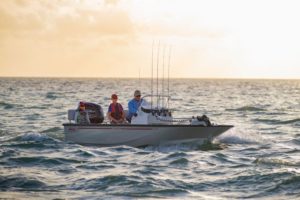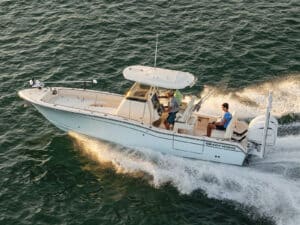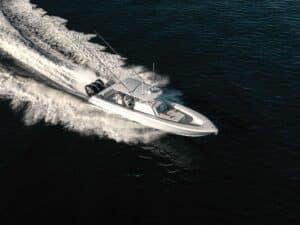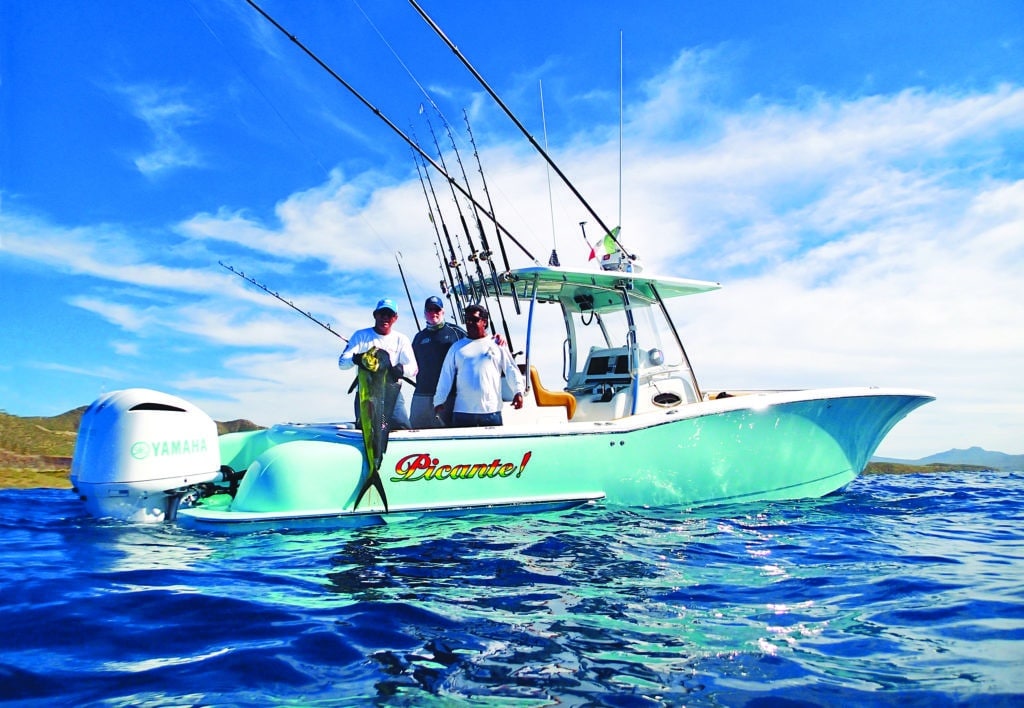
Mag Bay Yachts new 33
Darkness still enveloped Los Cabos Marina as I met Barrett Howarth, vice president of Mag Bay Yachts, at the Picante Sportfishing docks on an early December morning. “Ready to go fishing?” he asked while carting bags of ice down the gangway to our boat. “You bet,” I replied.
The Mag Bay 33 tugged at its dock lines. This particular 33 is the latest addition to the vaunted Picante fleet of fishing boats in Cabo San Lucas, Mexico.
Even in the dark, the Mag Bay draws a lot of attention. One reason is its lineage. Howarth’s father, Mike Howarth, was a founding partner of Cabo Yachts. Barrett helped build Cabo boats from an early age.
The father-son team started Mag Bay Yachts in 2014, developing the inaugural model, the 33, in the same facility where Cabo Yachts was born, in the high desert of Southern California. Those who know the legendary line now anticipate great things from Mag Bay.
A big storm in the Pacific pushed mountainous swells in our direction. The boat confidently met each and landed smoothly on the back sides.
Yet even without the history, this Mag Bay turns heads. Its broken sheer, flaring bow and contoured tumblehome in the stern quarters lend it a unique, captivating style.
Capt. Eduardo Gonzalez and first mate Antonio Romero soon joined us, and we were off, idling out the main channel amid a veritable herd of boats, all heading to sea for a day of fishing. The Mag Bay’s SeaStar Solutions Optimus electronic power steering allowed us to easily maneuver among the fleet.
We planned to target yellowfin tuna at the San Jaime Bank, about 22 nautical miles from the iconic rock arch synonymous with Cabo San Lucas.
At a stop outside the harbor, we transferred about 30 live caballitos — bigeye scad — from the panga-style boat of a local bait vendor to the Mag Bay’s 70-gallon pressurized transom livewell. A 40-gallon pressurized livewell lies beneath the aft deck.
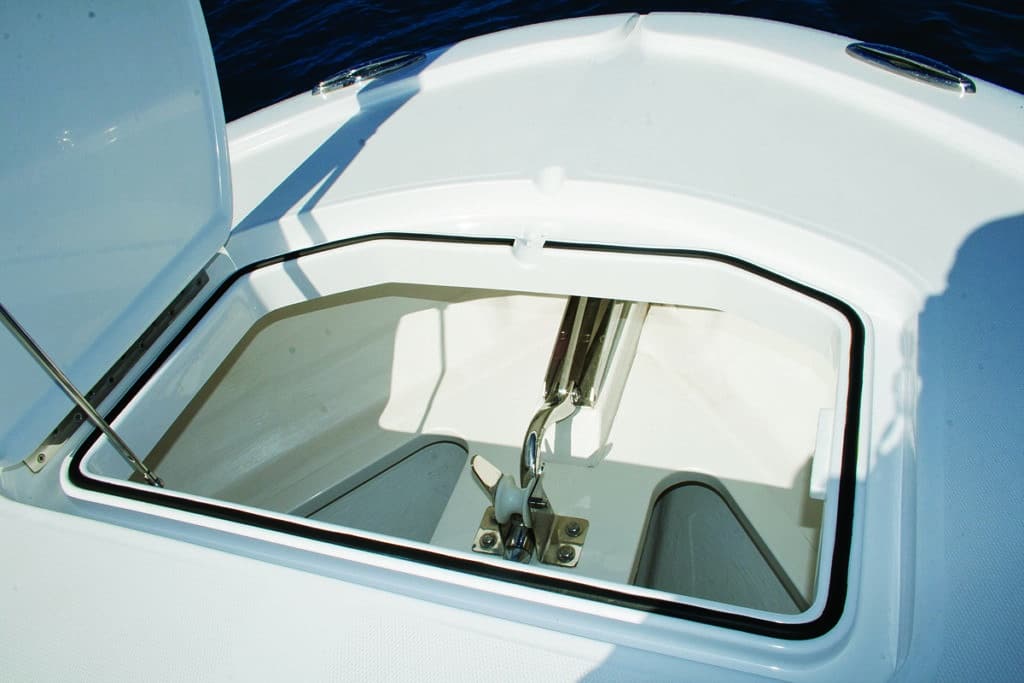
The Mag Bay Yachts 33 is Built to Fish
Swell Trip
As the sun peeked over the horizon, Gonzalez accelerated and turned southwest. The Michael Peters-designed twin-stepped hull lifted nicely as a pair of Yamaha F300 outboards propelled us to 38 mph at 4,500 rpm.
A big storm in the Pacific pushed mountainous swells in our direction. The boat confidently met each and landed smoothly on the back sides. I felt nary a drop of spray, whether perched on the 42-inch-wide bench-style helm seat or standing abaft the 33’s well-appointed rigging station.
Conditions grew more challenging near the bank. Capping waves decorated the increasingly steep swells. Though Gonzalez eased back the speed to 26 mph, the soft ride continued to impress me, as did the stability of the 10-foot beam in the trough.
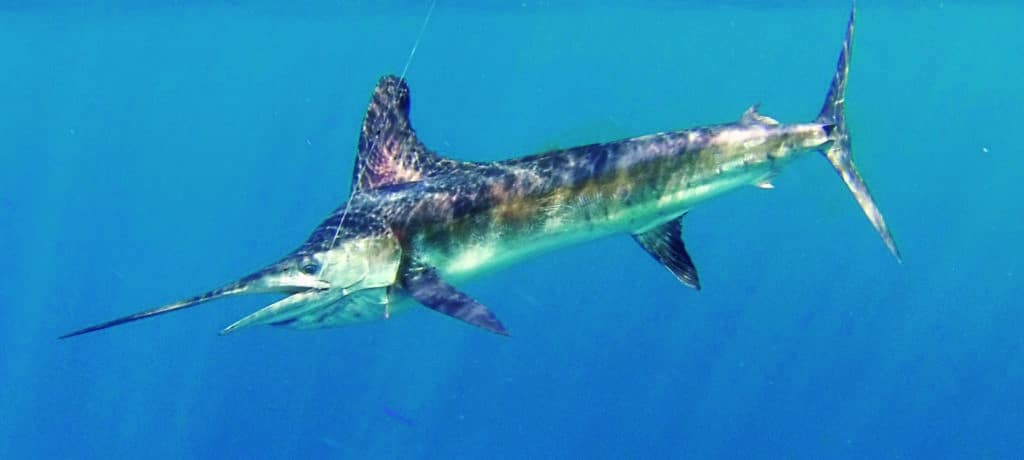
Bonus Billfish
First Marlin Caught Aboard a Mag Bay 33
Gonzalez used the sonar and charts displayed on the twin flush-mounted Simrad NSS12 evo2 screens to confirm that we were on the spot, then brought the speed down to about 8 mph. Howarth and Romero deployed the outriggers from underneath the hardtop to troll small skirted lures. They also set two flat lines with similar lures.
Soon we noticed frigate birds circling, and splashes underneath them, west of the bank. Gonzalez advanced the Yamaha electronic throttle to close the distance quickly, then slowed to trolling speed as we approached the action. The port outrigger line instantly snapped free as the rod bent over hard and line peeled off the 30-wide lever-drag reel.
“Marlin!” yelled Gonzalez. One hundred feet astern, a striped marlin went airborne. Once. Twice. Three times. I picked up the rod as the crew cheered. At this point, I appreciated the padded coaming bolsters encircling the interior. With 26-inch-high gunwales in the stern, the bolsters nicely cushioned my legs just above the knees.
Within 15 minutes, the marlin was boat-side. Gonzalez wired and held the fish for a few quick photos before releasing it. Only afterward did we realize that this was the first marlin caught aboard a Mag Bay 33. Kudos to the Picante crew for breaking the ice.
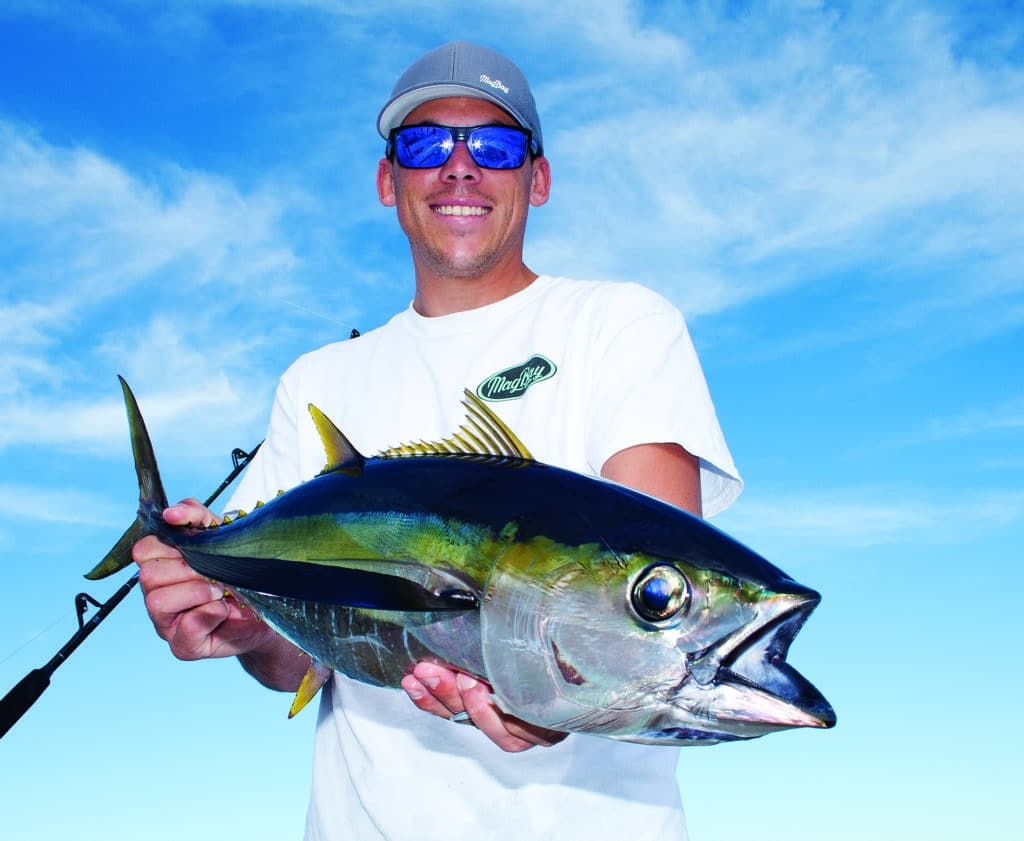
Yellowfin Galore
Tuna Town
The water suddenly swarmed with school-size yellowfin tuna. Howarth and crew cast metal jigs for them and enjoyed multiple hookups. The level deck and 3-foot-high forward gunwales allow as many as four anglers to fish from the spacious bow area. Twenty-five-inch-wide walkways aside the console made it easy to walk back to the 58-by-98-inch aft cockpit to land a fish.
We kept six tuna, icing them in one of two 73-gallon fish lockers flanking the aft deck. A third 220-gallon fish box resides under the foredeck, and it can be optionally plumbed to serve as a third livewell.
To rinse off the blood and slime from the diamond nonskid sole, the crew used a coil hose connected to the aft raw-water washdown. There’s a second raw-water bib forward. These are mirrored by two fresh-water washdown outlets.
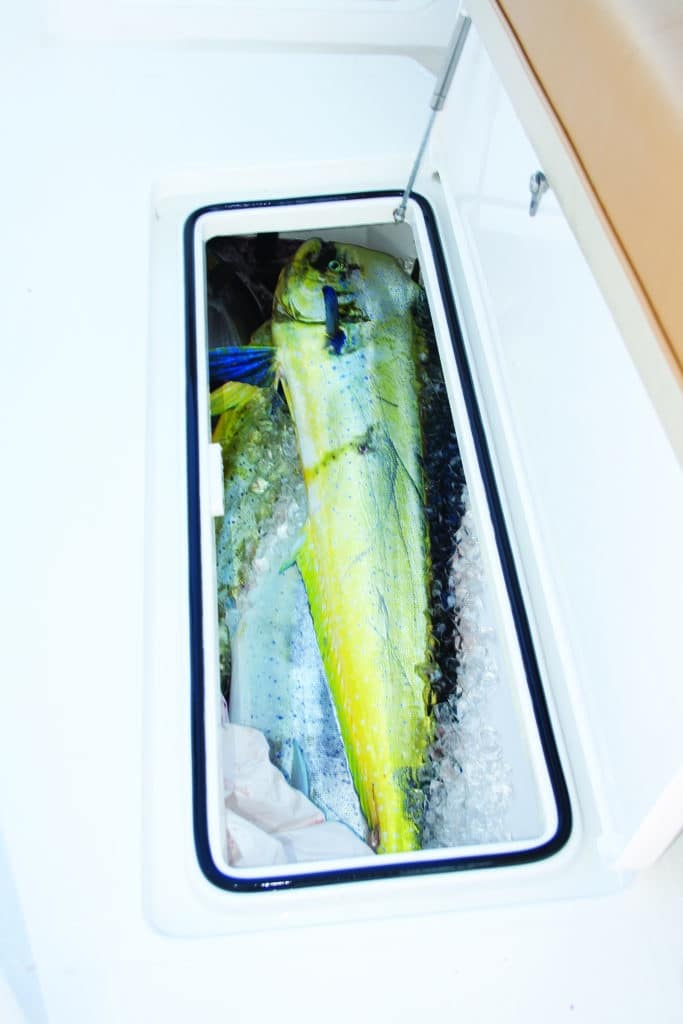
Ice ‘Em Down
Mahi Mission
With marlin and tuna checked off the list, we headed closer to the coast for mahimahi. This gave me a chance to try the 62-inch-long, 46-inch-wide lounger in front of the console, and I found it quite comfy. I also used the handy storage underneath to stash my camera gear.
I tried the padded seat atop the 85-quart Frigid Rigid cooler that slides out from under the rigging station. While not as luxurious as the lounger, it’s a great place to take a load off.
The Mag Bay 33 features a step-down head compartment in the console with a permanent marine head and sink. Accessible via a companionway on the port side, it boasts 80 inches of headroom.
As we arrived on the mahi grounds, the crew again set out trolling lures, and it didn’t take long for the fish to find them. Within minutes we had a double hookup. As Howarth and I battled the fish close to the boat, both Gonzalez and Romero cast live baits behind them, resulting in a quadruple hookup. I marveled at how easily we could fight four mahi at once from the deck of the Mag Bay.
With the fish on ice, it was time to gather performance data. A heavy load of fuel, four adult males, ice, fish and livewells full of water would render this a real-life test.
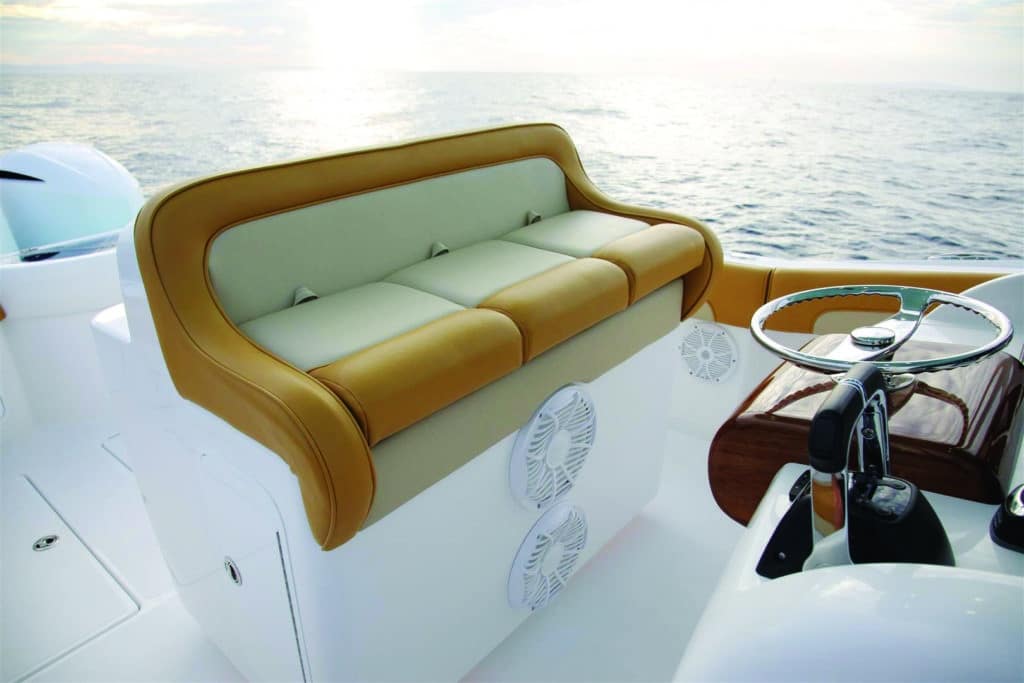
Mag Bay 33 Control Center
Turning PowerTech! 17-inch-pitch, four-blade stainless-steel propellers, the Mag Bay 33 planed in 8.6 seconds and reached 30 mph in 13 seconds, en route to a top speed of 51 mph at 5,800 rpm. At wide-open throttle, the twin Yamaha F300s burned 52.6 gallons per hour for 0.96 mpg.
My testing revealed the most efficient cruising speed as 38.3 mph (4,500 rpm), where the outboards burned 31.9 gallons per hour, resulting in 1.2 mpg. That equates to a maximum range of 405 miles based on the 338-gallon fuel capacity.
In an era when high-end center-consoles abound, it takes something special to stand out. Based on my experience aboard the Mag Bay 33, Mike and Barrett Howarth have achieved that goal, building a state-of-the-art fishing machine that combines visionary styling and quality with a high level of functionality. With this family’s boating background, I would have expected nothing less.
Mag Bay 33 Performance Specifications
POWER Twin Yamaha F300 outboards
LOAD 236 gal. fuel, four crew, full livewells, ice
TOP SPEED 51 mph @ 5,800 rpm
TIME TO 30 MPH 13 sec.
BEST MPG 1.2 @ 38 mph (4,500 rpm)
Hull Specifications
LOA 33 ft. 6 in.
BEAM 10 ft.
DEADRISE 22 deg.
DRY WEIGHT Approx. 10,200 lb.
DRAFT 24 in. (motors down)
FUEL 338 gal.
MAX POWER 700 hp
MSRP as tested $335,000 (w/ twin Yamaha F300s)
Mag Bay Yachts
Adelanto, California
949-395-0437

